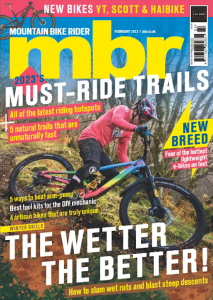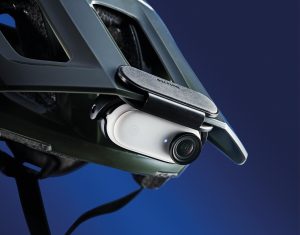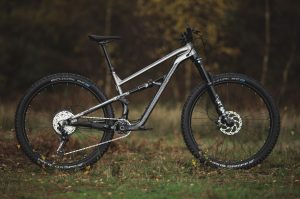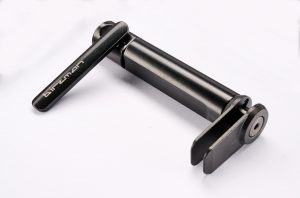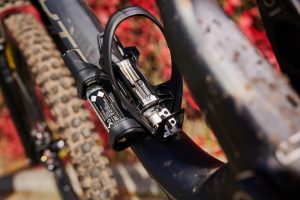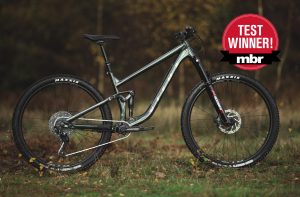Looking for the slickest shifting and widest gear range? Here's our guide to the best mountain bike drivetrains and groupsets from SRAM, Shimano and others.
Although historically referred to as groupsets, the component system on your bike that provides forward propulsion is now more regularly known as a drivetrain. It comprises a shifter, rear derailleur (or rear mech), cranks, chainring, chain, cassette, bottom bracket and cables (unless it’s a wireless drivetrain like SRAM AXS). The groupsets featured here do not include even the best mountain bike disc brakes. “Groupset” is pretty a byword for “drivetrain”.
Taking a purist’s view, you could also include hubs in that list, but modern bikes rarely come with complete drivetrains of a certain spec level, and even fewer come with hubs from the same stable as the rear mech and shifter. Increasingly bike manufacturers take a pick-and-mix approach depending on their budget and availability of in-house components. Even if you’re buying a complete drivetrain aftermarket – if you’ve bought one of the best mountain bike frames for instance – or upgrade your existing bike, most drivetrains comprise only the bare bones of what would have been considered a complete groupset in the past.

Shimano Deore M6100
Shimano Deore M6100
Best bang for your buck
Price: £365
Shimano’s unsung hero groupset delivers so much bang for buck it’s all we really need on a mountain bike. 12-speed with a single-ring crank, wide-range 10-51t cassette and low-profile Shadow mech with switchable clutch, it’s got all the basics covered. Fit and finish is up to Shimano’s usual high standards and ergonomic controls ensure the right ratio is always at your fingertips.

SRAM GX Eagle
SRAM GX Eagle
Quality shifting, security and styling at a reasonable price
Price: £365
Smooth pedalling, positive shifting and the best chain security marks the latest SRAM GX Eagle out as the best real world groupset in the SRAM range. SRAM’s new finish and refined features have elevated this workhorse drivetrain to new altitudes, while the broader wingspan of the Eagle cassette lets you soar with less effort.
Read our full test review of the SRAM GX Eagle drivetrain
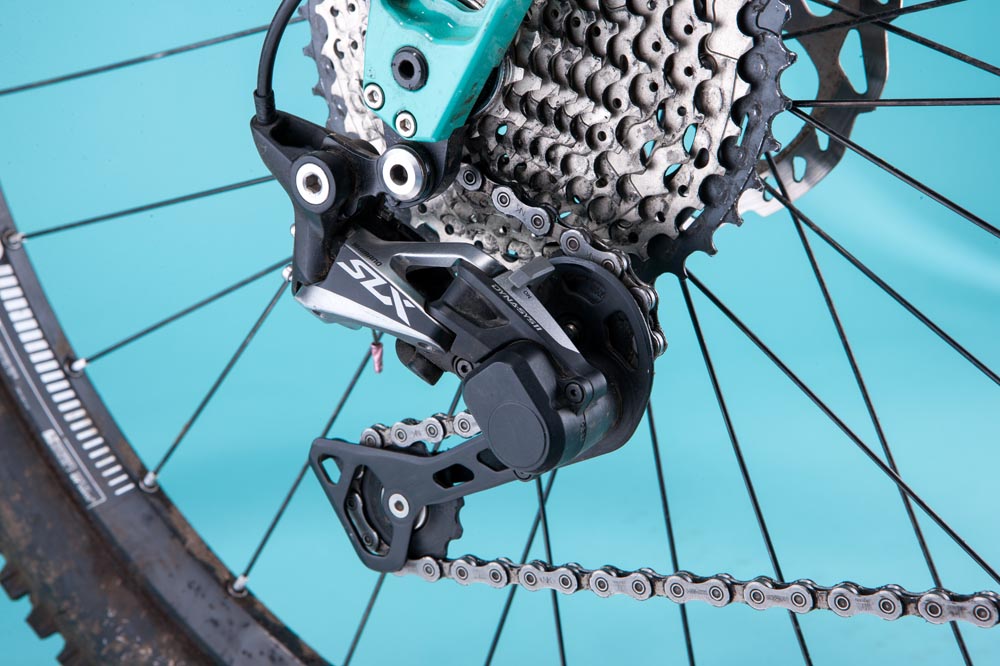
Shimano SLX M7000
Shimano SLX M7000
NB: 11-speed (if you can find it)
Price: £351.94
NB: this is for the older 11-speed SLX. One of our favourite MTB gruppos of all time. Was/is SLX 11-speed better than SRAM’s NX 11-speed Yes, undoubtedly. Shifting is easier, slicker and the cranks are stiffer. Was/is it better than the pricier SRAM 12-speed Eagle GX? It really depends on what deals you can find – and if you have outlay any further money on converting your wheel’s freehub to a different design (ie. XD driver for SRAM Eagle GX). Well worth a quick trawl of the internet – or real world local bike shops – to put together a classic and dependable wide-range 11-speed marvel.
Read our full test review of Shimano SLX M7000

SRAM X01 Eagle AXS
SRAM X01 Eagle AXS
Wireless shifting for the ultimate in speed and efficiency
Price: £1,900
SRAM’s AXS system currently offers the ultimate shifting in mountain biking. Ridiculously easy to install and set-up, boasting impressive real world battery life, superbly precise light-action shifting and a surprisingly robust build, AXS is the ultimate choice for any dream build.
Read our full test review of the SRAM X01 AXS upgrade kit

Microshift Advent X
Microshift Advent X
Alt. brand bargain brilliance
Price: £134.97
Microshift Advent X is remarkably good for the price; it’s reliable, shifts well enough and doesn’t weigh a ton. It would make a great expendable setup for e-bike use, where chains and cassettes have a hard life, or simply as a trail bike drivetrain for high mileage riders. Sort out the slightly firm lever action (yes, we are a really picky punch of bleeders) and we could see it getting awarded full marks.
Read our full test review of Microshift Advent X
The two big S brands
As a rule* it’s best to stick with one of the two big brands – Shimano or SRAM – for the major components in the system (chain, cassette, derailleur and shifter), but there’s nothing stopping you mixing and matching different drivetrain levels from the same brand. So you could run a SRAM X01 cassette with a GX rear mech and shifter. Or a Shimano XT 12-speed shifter with a Deore 12-speed mech. You can also choose to run third party hubs, bottom brackets, cables, chainrings and cranks if you wish. In fact this is sometimes a smart move.
(*rules are made to be broken, which is why we’ve gone and recommended a Microshift drivetrain in our top 5!)
Shimano drivetrains
Shimano’s named and numbered proper mountain bike groupsets for XC/trail/enduro riding. NB: the series number is important, it denotes it’s the latest version of the groupset tier, eg. Shimano XT M8100 is current XT.
- Shimano XTR M9100
- Shimano XTR M9050 Di2
- Shimano XTR M9000
- Shimano XT M8050 Di2
- Shimano XT M8100
- Shimano SLX M7100
- Shimano Deore M6100
Shimano also make two gravity/downhill groupsets (although Saint also designed for enduro, as is Zee, which also strays into ‘aggressive trail riding’ too).
- Shimano Saint M820
- Shimano Zee M640
SRAM drivetrains
SRAM’s named groupsets for mountain bikes. Starting with the top level.
- SRAM XX1 Eagle AXS
- SRAM X01 Eagle AXS
- SRAM XX1 Eagle
- SRAM XX1
- SRAM X01 Eagle
- SRAM X01
- SRAM EX 1 (designed for e-bikes)
- SRAM GX Eagle AXS
- SRAM GX Eagle
- SRAM GX
- SRAM NX Eagle
- SRAM NX
- SRAM SX Eagle
More sprockets, fewer chainrings
Back in the day, mountain bike drivetrains were all about pushing ever larger numbers of gears, but in the last ten years they’ve moved away from more is better, to simpler, lighter, more effective single-ring drivetrains. Instead of having two or three chainrings mounted to the cranks, along with a front derailleur and a second shifter, now there is just one front chainring, with specially shaped teeth that stop the chain from falling off in rough terrain.
The single front chainring is connected to a stack of sprockets mounted to the rear hub. Most modern drivetrains have 12 such sprockets fixed together into a cassette that slides onto a splined interface at the hub. Inside this is a ratchet freewheel mechanism, that allows the sprockets to rotate anti-clockwise against the rotation of the wheel, so that you can stop pedalling. There are several of these freehub bodies depending on who makes the drivetrain; SRAM uses the XD driver body design, while Shimano uses a splined interface for 11-speed and fewer, while its 12-speed drivetrains mount on a smaller Microspline unit.
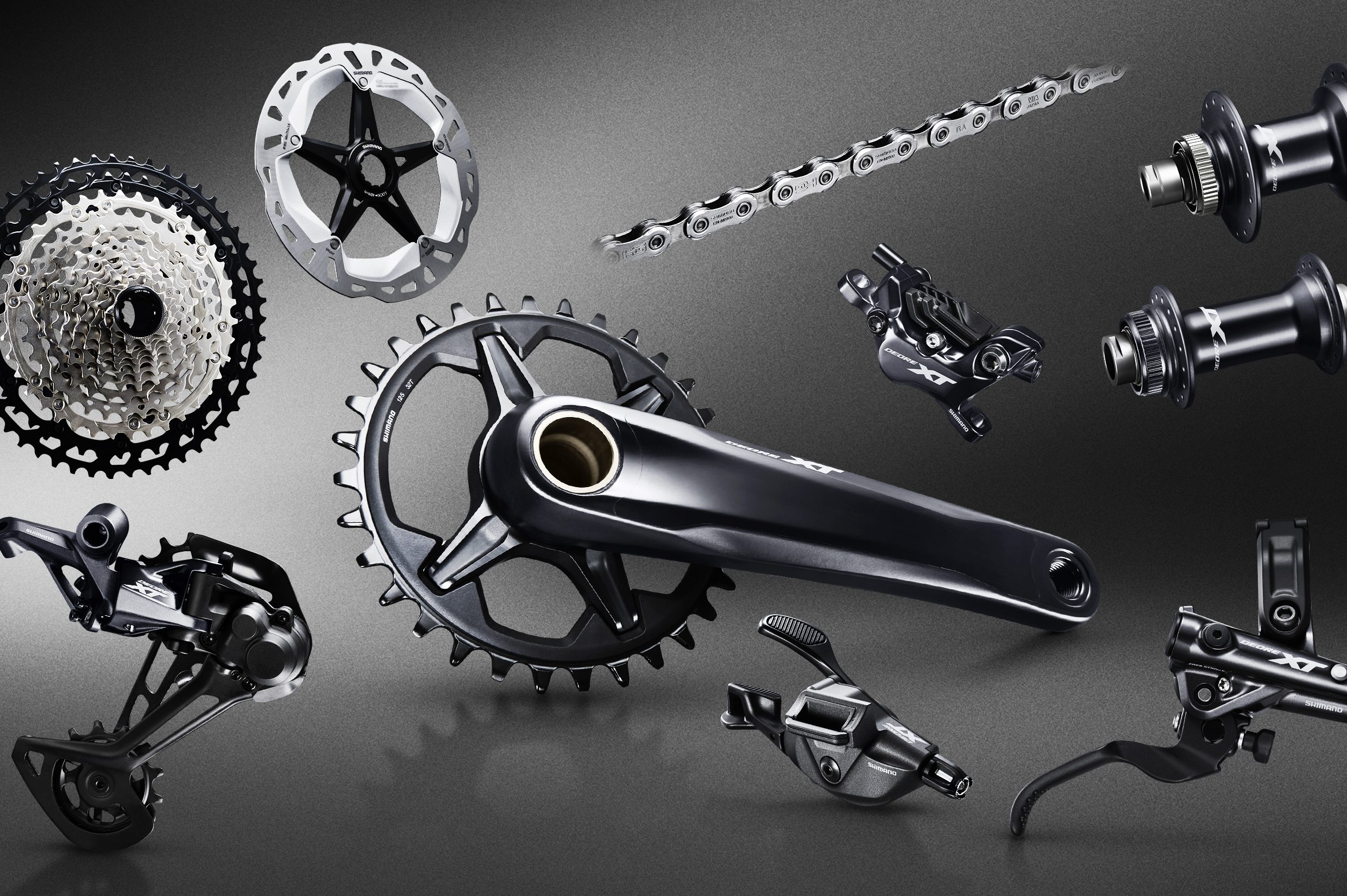
Components of mountain bike groupsets
Components of mountain bike groupsets:
Generally when people are talking about “groupsets”, the focus is on all of the bits that run between the pedals and the rear wheel (also called the drivetrain). Normally this groupset comprises of front and rear derailleurs, shifters, chainset, bottom bracket, chain and cassette.
‘Back in the day’ a groupset also used to always include things like brakes, wheels and even headsets etc. But these days no-one really includes things like wheels in when discussing groupsets.

SRAM GX Eagle 24mm cranks
Chainset
The chainset comprise the crank arms, bottom bracket axle and front chainrings. For modern mountain biking the majority of chainsets feature either a single front chainring or a double (two chainrings).
There is a vast range of chainring sizes to choose from, with the size being dictated by how many teeth the ring comprises. In simple terms, the more teeth equates to harder gearing but more speed, whilst smaller chainring sizes will provide easier gearing for better climbing prowess.
Opting for a double chainset will provide a greater spread of gears to encompass both ends of the spectrum; a smaller inner chainring for climbing and a larger outer for higher speeds and descending.

Carbon cranks can offer a decent weight saving
Often the style of bike will dictate the most suitable chainring size.
Longer travel, burlier bikes intended for trail centre black routes or more aggressive riding terrain tend to have smaller chainrings, such as 28 or 30 tooth chainrings. This is to provide easier gearing to suit the more slow speed, sit down and spin style of climbing that riders tend to adopt.
Shorter travel or more cross country oriented bikes can get away with larger chainring, 34 or 36 tooth being more frequent options. Again, these styles of bikes tend to be more efficient climbers and can cope with faster, more aggressive or out of the saddle climbing.
Crank arm lengths
The crank arms themselves can also vary in length, although the most common length is 170mm, which gives a little more clearance when cornering and pedalling without compromising too much on leverage.
As our technological and biomechanical understanding has increased crank arm length can be determined by rider measurements and intended use of the bike.
Longer (175mm+) cranks offer a better mechanical advantage but are harder to turn and so are better suited to taller riders and for more XC oriented bikes.
Shorter (165 or 170mm cranks) are easier to pedal, better for riders with shorter legs and also reduce the likelihood of pedal strikes.

Trigger shifters are the most common shifter style
Shifters
The majority of mountain bike gear shifter are of the under-bar, trigger style (although SRAM do still produce a twist-grip that rotates around the bar). These trigger shifters normally use two levers that can be either pushed or pulled to change to an easier or harder gear.
Shimano shifters have a thumb pushed trigger to change to an easier gear (downshift). Behind which a secondary lever can be either pulled with the index finger or pushed with the thumb to return to a harder gear (upshift).
SRAM utilise gear shifters that incorporate two thumb pushed triggers in a similar orientation. Both Shimano and SRAM allow multiple downshifts dependent on how far you push the forward trigger.
Box is another manufacturer that uses a unique single trigger shifter. Downshifts are produced in the same way as other styles, however upshifts are provided by depressing the trigger end inwards toward the shifter body.

12-speed SRAM Eagle drivetrain is impressive for the price
Derailleurs AKA mechs
It’s crazy to think that in its current form the derailleur systems are fundamentally no different to those produced in the 1920s! Although they might look complex, their job is to simply push the chain from one gear sprocket/chainring to another.
Modern mountain bike derailleurs have developed very strong springs to aid chain retention and minimise chain bounce.
Shimano has its Shadow+ system, with a switch to reduce tension allowing easier wheel removal. SRAM’s Type 2 system has a mechanical pin that can hold the derailleur in a de-tensioned state so it too can allow wheel removal.
Whilst Shimano still produces front derailleurs for all of its groupsets, SRAM has fully committed to the 1x drivetrain.

Two largest sprockets on XT cassette are alloy. SLX only gets alloy 51t sprocket.
Cassette
Number of cogs and cog sizes are the most important factors for a cassette. Situated at the rear wheel, the cassette (asometimes known as the block) is responsible for the fine-tuning gear changes that make up the majority of everyday gear shifts.
Cog numbers can be anywhere from 7 to 12 depending on the groupset. The advantages of having more cogs is that you either have less ‘jumps’ in the spread of gears or a wider range.
SRAM has the drop on Shimano with its 12 speed Eagle groupsets. These have the widest gear range of any cassette, going from the smallest, 10 tooth cog to the massive 52 tooth cog. Shimano isn’t far behind, however, with 10-51t cassettes. These wide ratio cassettes are ideally suited for groupsets running a single front chainring.

A chain, yesterday
Chain
Often overlooked, without the chain a bike is useless. The type of chain is linked to the number of cogs in the cassette. The more cogs, the narrower the space is between the cogs (as all cassettes effectively have to be the same width). Correspondingly the chain links will alter in width, with a 7 speed chain being significantly wider than a 12 speed chain.
You shouldn’t mix different speed chains and cassettes. Chains, like cassettes wear with use and so should be changed frequently.

What do you get for your money when buying a groupset?
Looking through the groupsets on offer it is obvious that prices can increase dramatically between tiers. But what do you get when you spend more money?
Is it worth pushing to XT over SLX or XX1 over GX?
Performance
As prices increase so too does the level of of construction and material tolerances that the components are built to. This is evident in the quality of the gear shift.
The shifting from higher tier groupsets is often smoother, more immediate and more precise. This allows them to perform better even under load (when climbing, for example). Whereas a low tier shifting performance might seem more clunky, unreliable or delayed. High end parts will use bearings for pivots, while lower end units will rely more on bushings, which can develop play and get sloppy over time.
As you go further up the ranges shifting performance tends to be quite consistent, due in part to the level of shared component technologies.
Weight is another aspect that changes as prices rise. At the lower end expect more components to be made from basic materials such as pressed steel or to feature less intensive machining and manufacturing processes. Higher tier groupsets tend to be lighter, often using more exotic materials such as carbon fibre or titanium.
Durability
Probably of more importance to the average mountain biker is how long the components are expected to last. It’s often the mid-level groupsets such as SLX or GX that have components that, with the right care, can last a long time.
Higher tier groups such as XTR or XX1 Eagle were often considered ‘raceday’ components, as the lightweight nature of the parts would see them wear more quickly if used on a daily basis. But now, hi-tech coatings and durable materials mean that the top end chains and cassettes are often equally durable, or even longer lasting, than lower priced components.
What’s available?
Mountain bike groupsets: buyer’s guide essential info.

Always a shrewd cost-effective choice, SLX offers much of XT’s performance at a lower price
Shimano
Shimano currently produces seven specific MTB groupsets, plus other general purpose groupsets/components that bike companies might employ on lower models, such as Acera and Altus.
All Shimano groupsets are designated with a well recognized name that remains the same no matter the model year. Shimano also include a numerical code to easily identify chronologically different versions.
For example, one current version of XTR is coded M9100 (The M implies ‘Mountain’).
Currently Shimano’s MTB groupsets from XTR to Deore run 12 speeds.
Talking about chainsets, Shimano only produce a single, 24mm diameter axle option on all of its chainsets. Different bottom bracket styles are required to be able to fit to a specific frame.

Shimano XTR Di2
Di2 electronic shifting
Shimano offers electronic shifting in the shape of Di2 for its as options for its XTR and XT groupsets. These Di2 groupsets lose the cable operated derailleurs and shifters and instead rely on battery run derailleurs and simple button-like shifters.
The upside of this electronic shifting is incredible reliability with none of the degradation of shift quality that can occur when cables become stretched or contaminated with dirt and water.
Another neat trick of the Di2 system is the ability to run both front and rear derailleurs off one shifter, using Shimano’s Synchro-shift. This automatically shifts the front derailleur depending on which gear you are in at the rear to allow a completely seamless shifting experience.
Which Shimano drivetrain is best for you?
And what do you get for your dollar?
Shimano XTR M9100
Shimano’s ultimate MTB groupset has always been a blend of exotic materials and lusty styling, and that remains the case today. Carbon and titanium top the list of wonder materials, while features such as Hollow-forged cranks, Shadow derailleurs and Ice-Tech rotors ensure impressive trail performance. Now 12-speed, XTR still gives you the option of running a dual ring chainset.
Shimano XT M8100
The workhorse of the range, and still a much more realistic option for riders than XTR. You get most of the performance and features with a little extra weight. There’s a 12-speed drivetrain with 10-51t cassette, Hollow-forged cranks, a clever shifter with two-way release and multi-shift (allowing you to shift upto four gears at a time, as well as push or pull the release lever to upshift) and two and four-piston brakes.
Shimano SLX M7100
More affordable than XT, SLX is almost impossible to differentiate in performance terms when riding. Sure, there’s a weight penalty to be had, but the main down grade is the simpler, single-release shifter. Our tip: pair a SLX mech with a XT shifter for the best performance for your cash.
Shimano Deore M6100
Recently given the 12-speed treatment, Deore continues to punch well above its weight. Decent shifting (it pings a bit under load) with a wide-range cassette and clean lines makes this a great entry-level drivetrain that can be upgraded as funds allow. If you’re upgrading from 11-speed, you will need to switch to the new Microspline driver body, which will almost certainly drive up the cost unless you have a compatible wheel/hub.

SRAM Eagle XX1
Which SRAM groupset is best for you?
SRAM pioneered the single-ring approach to drivetrains, coming up with the XD driver body and narrow-wide chainring as clever solutions to chain security and wide-range cassettes. Arguably they still hold the advantage in the drivetrain wars with wireless AXS shifting at one end of the spectrum, and sorted cable shifting with marginally wider range gearing at the other.
SRAM XX1 and SRAM XX1 Eagle
Now with AXS wireless shifting, or traditional cable operation, SRAM’s flagship drivetrains are jewel-like affairs. Despite the lightweight, vulnerable parts like the rear derailleur are surprisingly robust, and shifting and drivetrain durability are excellent thanks to trick coatings and sophisticated ramps and proffiling. For clean lines and rapid, effortless shifting, the AXS wireless option is next-level.
SRAM X01 and SRAM X01 Eagle
There’s very little to split XX1 and X01. In fact, on the surface they appear identical. However, whereas XX1 utilises the lightest weight parts making it ideal for weight conscious XC racers, X01 has more of an eye towards durability. Materials are a little bit heavier and construction is not quite as delicate, allowing X01 to be a little more applicable to ‘real world’ use. It still shares the same DNA and technological performance as XX1 just with a slight weight penalty.

SRAM GX Eagle
SRAM GX and SRAM GX Eagle
GX is SRAM’s most varied and widespread groupset. It as amongst the most popular groupsets or components that bike companies spec on their bikes, as it is available in 7, 10, 11 and 12 speed derivatives. All variations utilise some of the trickle-down technologies of higher end groupsets such as Type 2 derailleurs and X/Exact Actuation trigger shifters.
SRAM NX
NX opens up 11 speed and 1x shifting to a wide audience, being both reliable enough to put on mid range bikes but also by being great value. It might not have the exotic materials of higher groupsets, or the most refined finish but SRAM has still endowed NX with excellent performance.
Top tips when looking at groupsets on a new bike
Often when looking at purchasing a new bike the components and groupset are parts to consider.
Bike brands will very often fit the main components of one groupset but might drop a tier with parts such as chains and cassettes.
This is often to keep a bike within a certain price point but be aware and check with the shop as to the actual specifications.
Remember, components can be upgraded over time so it might be worth investing in a better quality frame with a lower tier groupset and keep one eye on future upgrades.
Which groupset should you get then?
First off, Shimano or SRAM? A couple of years ago this would have been an easier question to answer; SRAM were well ahead of the game compared to a caught-napping Shimano. SRAM appreciated the fact that pretty much all mountain bikers hate front mechs and love wide-as-possible range cassettes.
At the top of tree is where things really hot up. This is the tier that feels more like the old skool ding-dong battler between Shimano and SRAM. Shimano XTR or SRAM XX1? And to be frank, get either! Well, if you have the cash that is.
If pushed we’d say that Shimano XTR M9100 edges it in the mechanical shifting drivetrain arena and the new SRAM Eagle AXS stuff is leading the way in the electronic wireless market.


